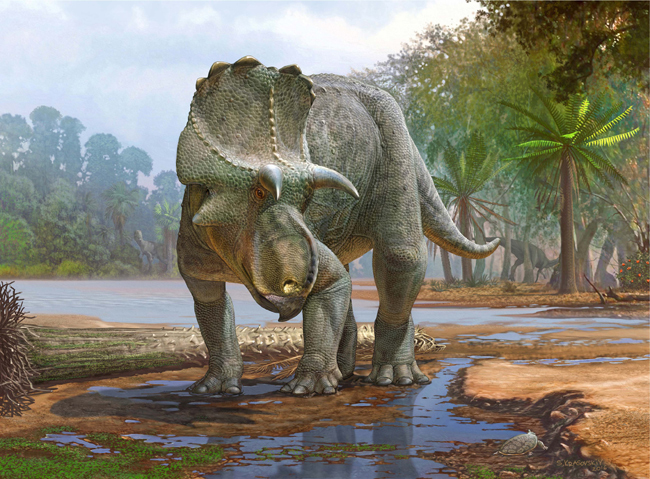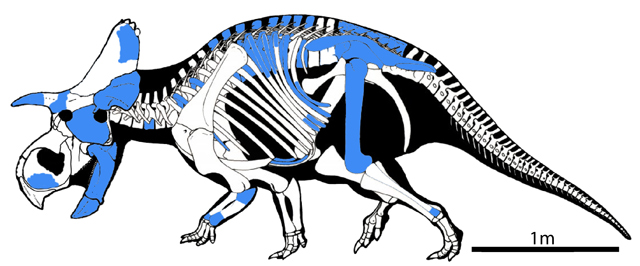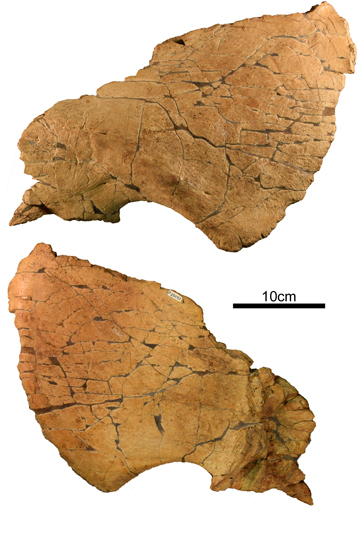Menefeeceratops – The Oldest Centrosaurine? That’s a Great Question!
Fossilised dinosaur remains found over twenty years ago have been re-examined and determined to represent a new species of horned dinosaur. Menefeeceratops (M. sealeyi) from the early Campanian of New Mexico, might just be the oldest centrosaurine described to date.

From the Menefee Formation of New Mexico
Researchers from the University of Pennsylvania, the New Mexico Museum of Natural History and Science in collaboration with a colleague from the State Museum of Pennsylvania, writing in the academic journal Paläontologische Zeitschrift, report on the reassessment of ceratopsian bones originally collected at a site near to Cuba, in New Mexico. The fossils, representing a partial skeleton of a single dinosaur were found by Paul Sealey, a research associate at the New Mexico Museum of Natural History and Science, whilst exploring the Allison Member of the Menefee Formation in 1996 and discussed in academic literature a year later but no genus name was proposed or other research conducted.
The fossils which consist of cranial and postcranial material remained within the collection of the New Mexico Museum of Natural History and Science, however, with dinosaurs being named and described from the Menefee Formation such as the tyrannosaur Dynamoterror dynastes and the nodosaurid Invictarx zephyri, both of which were named and described in 2018, interest in this specimen was reawakened. Further preparation revealed unique traits associated with the skull material that permitted the establishment of a new genus.

Menefeeceratops sealeyi
Classified as a basal member of the Centrosaurinae, Menefeeceratops sealeyi helps palaeontologists to piece together the evolutionary history of the Ceratopsia. Estimated to have lived around 82 million years ago (Early Campanian), the authors of the scientific paper Sebastian Dalman, Spencer G. Lucas and Asher Lichtig (New Mexico Museum of Natural History and Science), Steven Jasinski (State Museum of Pennsylvania) and Peter Dodson (University of Pennsylvania) postulate that Menefeeceratops represents the earliest member of the centrosaurine subfamily of horned dinosaurs known to science.
The distinctive shape of the squamosal (skull bone that formed part of the neck frill), permitted the scientists to erect a new genus. The name honours the Menefee Formation, whilst the trivial name recognises the work of Paul Sealey, not only for the original discovery but for his contribution to the study of the dinosaurs of New Mexico.

How Big was Menefeeceratops?
By comparing the bones of Menefeeceratops to more complete centrosaurine specimens, the research team were able to estimate the size of this dinosaur. They conclude that it was relatively small, when compared to later members of the Centrosaurinae such as Pachyrhinosaurus and Styracosaurus, at around 3.9 to 4.4 metres in length.
Commenting on the significance of the reassessment of the fossil material that led to the naming of Menefeeceratops, co-author of the scientific paper Spencer G. Lucas stated:
“Menefeeceratops shows us just how much we still have to learn about the horned dinosaurs of western North America. The oldest centrosaur, Menefeeceratops indicates that the southwest region of the United States was an important place in the evolution of the centrosaurs. The recognition of this new centrosaur adds to a growing diversity of centrosaurs, and thus provides impetus to further efforts to discover fossils of these kinds of dinosaurs.”
Authors involved in this study, also named and described the related but geologically much younger centrosaurine Crittendenceratops. To read about Crittendenceratops krzyzanowskii: A New Horned Dinosaur from Arizona.
Everything Dinosaur acknowledges the assistance of a media release from the University of Pennsylvania in the compilation of this article.
The scientific paper: “The oldest centrosaurine: a new ceratopsid dinosaur (Dinosauria: Ceratopsidae) from the Allison Member of the Menefee Formation (Upper Cretaceous, early Campanian), north-western New Mexico, USA” by Sebastian G. Dalman, Spencer G. Lucas, Steven E. Jasinski, Asher J. Lichtig & Peter Dodson published in Paläontologische Zeitschrift.
Visit the Everything Dinosaur website: Dinosaur Toys.

